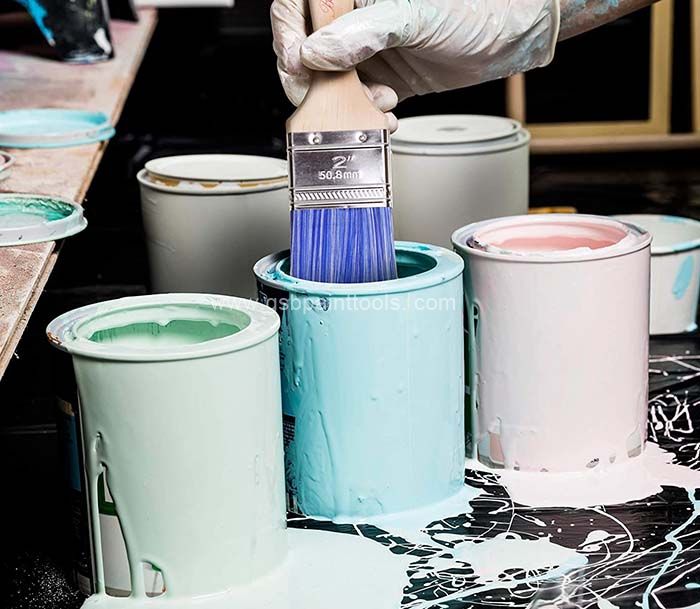Angled Paint Brush: A Versatile Tool for Precise Painting
An angled paint brush is a valuable tool that every painter, whether professional or amateur, should have in their arsenal. With its unique design and angled bristles, this versatile brush offers numerous advantages over traditional straight brushes. In this article, we will explore the features and benefits of an angled paint brush, highlighting its ability to deliver precise and smooth strokes, reach tight corners, and enhance overall painting efficiency.
The Advantages of an Angled Paint Brush
Precise and Controlled Painting
The angled shape of the bristles sets the angled paint brush apart from its straight counterparts. This design enables painters to achieve more precise and controlled strokes. The tapered edge of the brush allows for greater accuracy when cutting in or painting along edges, resulting in cleaner lines and a more professional finish. Whether you're painting trim, edges, or intricate details, the angled paint brush provides the necessary control for achieving exceptional results.
Efficient Coverage and Reduced Dripping
Another significant advantage of an angled paint brush is its ability to hold more paint while reducing dripping. The angled bristles create a larger reservoir for paint, allowing painters to cover more surface area with each dip into the paint can. The brush's design also helps prevent excess paint from accumulating at the base of the bristles, minimizing the chances of unwanted drips and streaks. This efficient paint load and distribution save time and effort during the painting process.
Accessibility to Tight Corners and Edges
One of the standout features of an angled paint brush is its capability to reach tight corners and edges with ease. The angled bristles allow painters to navigate around obstacles and access areas that are challenging to reach with straight brushes. Whether it's painting corners, window frames, or intricate molding, the angled paint brush excels at providing optimal coverage in these confined spaces. This accessibility ensures a consistent and uniform finish throughout the entire surface.
Versatility for Various Surfaces
The versatility of an angled paint brush makes it suitable for a wide range of painting projects and surfaces. It can effectively be used on both smooth and textured surfaces, such as walls, ceilings, furniture, and trim. The brush's angled shape adapts well to different contours and uneven surfaces, ensuring even paint distribution and minimizing brush marks. Whether you're working with latex paint, acrylics, or oil-based paints, the angled paint brush is a reliable tool for achieving professional results.
Time and Energy Saving
Due to its efficient coverage and precise painting capabilities, the angled paint brush can save both time and energy during painting projects. With fewer brushstrokes required to achieve even coverage, painters can complete their tasks more quickly without compromising quality. The brush's ability to cut in neatly also reduces the need for additional touch-ups, further streamlining the painting process. Ultimately, the angled paint brush enhances productivity and allows painters to accomplish more in less time.
Frequently Asked Questions (FAQs)
Q: How do I clean an angled paint brush?
A: To clean an angled paint brush, first, remove excess paint by scraping the bristles against the inside of the paint can. Then, rinse the brush with warm water or an appropriate solvent, depending on the type of paint used. Gently comb through the bristles with your fingers or a brush comb to remove any remaining paint residue. Finally, wash the brush with mild soap and water, reshape the bristles, and allow it to dry thoroughly before storing.
Q: Can I use an angled paint brush for other tasks besides painting?
A: Yes, an angled paint brush can be used for various tasks besides painting. Its precise and controlled application makes it suitable for applying stains, varnishes, or sealants to small or detailed surfaces. Additionally, the brush's angled shape allows for accurate glue application during craft projects or woodworking.
Q: What sizes are available for angled paint brushes?
A: Angled paint brushes come in a range of sizes, typically measured by the width of the brush head. Common sizes include 1 inch, 1.5 inches, 2 inches, and 2.5 inches. The choice of brush size depends on the specific painting project and the desired level of precision.
Q: Can I use an angled paint brush with watercolor or gouache paints?
A: While angled paint brushes are commonly used with thicker paints like latex or oil-based paints, they can also be used with watercolor or gouache paints. However, it's important to select a brush specifically designed for water-based paints, as these brushes typically have softer bristles that are more suitable for the delicate nature of watercolor and gouache techniques.
Q: Are angled paint brushes suitable for both amateurs and professionals?
A: Yes, angled paint brushes are suitable for painters of all skill levels, from beginners to professionals. The brush's unique design and advantages make it a versatile tool that enhances precision and efficiency, regardless of the painter's experience level.
Conclusion
In conclusion, a G.SB angled paint brush offers numerous benefits that make it an invaluable tool for painters. From its precise and controlled painting capabilities to its accessibility in tight corners and edges, the angled paint brush provides an enhanced painting experience. With its versatility, efficiency, and time-saving qualities, this brush is a must-have for anyone looking to achieve professional-quality results in their painting projects.

评论
发表评论